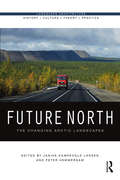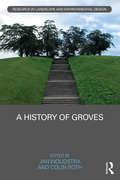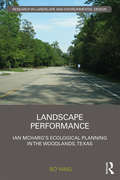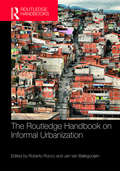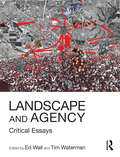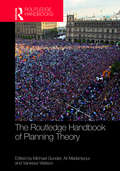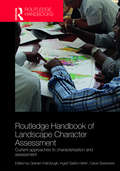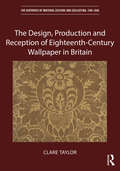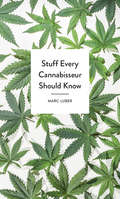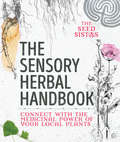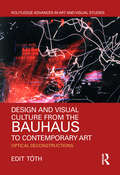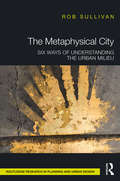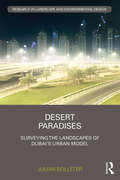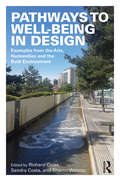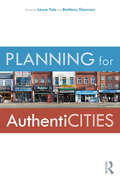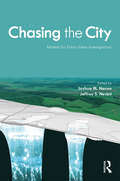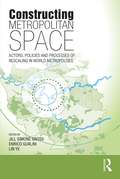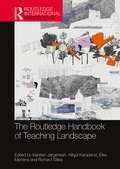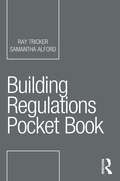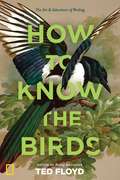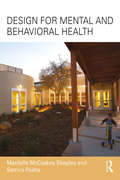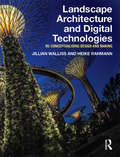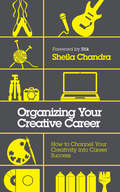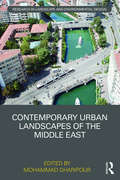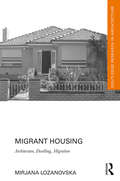- Table View
- List View
Future North: The Changing Arctic Landscapes (Landscape Architecture: History - Culture - Theory - Practice)
by Janike Kampevold Larsen Peter HemmersamThe changing Arctic is of broad political concern and is being studied across many fields. This book investigates ongoing changes in the Arctic from a landscape perspective. It examines settlements and territories of the Barents Sea Coast, Northern Norway, the Russian Kola Peninsula, Svalbard and Greenland from an interdisciplinary, design-based and future-oriented perspective. The Future North project has travelled Arctic regions since 2012, mapped landscapes and settlements, documented stories and practices, and discussed possible futures with local actors. Reflecting the multidisciplinary nature of the project, the authors in this book look at political and economic strategies, urban development, land use strategies and local initiatives in specific locations that are subject to different forces of change. This book explores current material conditions in the Arctic as effects of industrial and political agency and social initiatives. It provides a combined view on the built environment and urbanism, as well as the cultural and material landscapes of the Arctic. The chapters move beyond single-disciplinary perspectives on the Arctic, and engage with futures, cultural landscapes and communities in ways that build on both architectural and ethnographic participatory methods.
A History of Groves (Routledge Research in Landscape and Environmental Design)
by Jan Woudstra Colin RothThe grove, a grouping of trees, intentionally cultivated or found growing wild, has a long diverse history entwined with human settlement, rural practices and the culture and politics of cities. A grove can be a memorial, a place of learning, a site of poetic retreat and philosophy or political encampment, a public park or theatre, a place of hidden pleasures, a symbol of a vanished forest ecology, or a place of gods or other spirits. Yet groves are largely absent from our contemporary vocabulary and rarely included in today’s landscape practice, whether urban or rural. Groves are both literal and metaphorical manifestations, ways of defining spaces and ecologies in our cultural life. Since they can add meaning to urban forms and ecologies and contribute meaningfully to the significance of place, critical examination is long overdue. The editors have taken care to ensure that the text is accessible to the general reader as well as specialists.
Landscape Performance: Ian McHarg’s ecological planning in The Woodlands, Texas (Routledge Research in Landscape and Environmental Design)
by Bo YangIan McHarg’s ecological planning approach has been influential since the 20th century. However, few empirical studies have been conducted to evaluate the performance of his projects. Using the framework of landscape performance assessment, this book demonstrates the long-term benefits of a renowned McHargarian project (The Woodlands town development) through quantitative and qualitative methods. Including 44 black and white illustrations, Landscape Performance systematically documents the performance benefits of the environmental, social, and economic aspects of The Woodlands project. It delves into McHarg’s planning success in The Woodlands in comparison with adjacent Houston developments, which demonstrated urban resilience after Hurricane Harvey in 2017. Lastly, it identifies the ingredients of McHarg’s ability to do real and permanent good. Yang also includes a number of appendices which provide valuable information on the methods of assessing performance in landscape development. This book would be beneficial to academics and students of landscape architecture and planning with a particular interest in Ian McHarg.
The Routledge Handbook on Informal Urbanization
by Roberto Rocco Jan Van BallegooijenThe Routledge Handbook on Informal Urbanization investigates the mutual relationship between the struggle for political inclusion and processes of informal urbanization in different socio-political and cultural settings. It seeks a middle ground between two opposing perspectives on the political meaning of urban informality. The first, the ‘emancipatory perspective’, frames urban informality as a practice that fosters autonomy, entrepreneurship and social mobility. The other perspective, more critical, sees informality predominantly as a result of political exclusion, inequality, and poverty. Do we see urban informality as a fertile breeding ground for bottom-up democracy and more political participation? Or is urban informality indeed merely the result of a democratic deficit caused by governing autocratic elites and ineffective bureaucracies? This book displays a wide variety of political practices and narratives around these positions based on narratives conceived upon specific case cities. It investigates how processes of urbanization are politicized in countries in the Global South and in transition economies. The handbook explores 24 cities in the Global South, as well as examples from Eastern Europe and East Asia, with contributions written by a global group of scholars familiar with the cases (often local scholars working in the cities analyzed) who offer unique insight on how informal urbanization can be interpreted in different contexts. These contributions engage the extreme urban environments under scrutiny which are likely to be the new laboratories of 21st-century democracy. It is vital reading for scholars, practitioners, and activists engaged in informal urbanization.
Landscape and Agency: Critical Essays
by Ed Wall Tim WatermanLandscape and Agency explores how landscape, as an idea, a visual medium and a design practice, is organized, appropriated and framed in the transformation of places, from the local to the global. It highlights how the development of the idea of agency in landscape theory and practice can fundamentally change our engagement with future landscapes. Including a wide range of international contributions, each illustrated chapter investigates the many ways in which the relationship between the ideas and practices of landscape, and social and subjective formations and material processes, are invested with agency. They critically examine the role of landscape in processes of contemporary urban development, environmental debate and political agendas and explore how these relations can be analysed and rethought through a dialogue between theory and practice.
The Routledge Handbook of Planning Theory
by Michael Gunder Ali Madanipour Vanessa WatsonThe Routledge Handbook of Planning Theory presents key contemporary themes in planning theory through the views of some of the most innovative thinkers in planning. They introduce and explore their own specialized areas of planning theory, to conceptualize their contemporary positions and to speculate how these positions are likely to evolve and change as new challenges emerge. In a changing and often unpredictable globalized world, planning theory is core to understanding how planning and its practices both function and evolve. As illustrated in this book, planning and its many roles have changed profoundly over the recent decades; so have the theories, both critical and explanatory, about its practices, values and knowledges. In the context of these changes, and to contribute to the development of planning research, this handbook identifies and introduces the cutting edge, and the new emerging trajectories, of contemporary planning theory. The aim is to provide the reader with key insights into not just contemporary planning thought, but potential future directions of both planning theory and planning as a whole. This book is written for an international readership, and includes planning theories that address, or have emerged from, both the global North and parts of the world beyond.
Routledge Handbook of Landscape Character Assessment: Current Approaches to Characterisation and Assessment
by Graham Fairclough Ingrid Sarlöv Herlin Carys SwanwickIn this multi-authored book, senior practitioners and researchers offer an international overview of landscape character approaches for those working in research, policy and practice relating to landscape. Over the last three decades, European practice in landscape has moved from a narrow, if relatively straightforward, focus on natural beauty or scenery to a much broader concept of landscape character constructed through human perception, and transcending any of its individual elements. Methods, tools and techniques have been developed to give practical meaning to this idea of landscape character. The two main methods, Landscape Character Assessment (LCA) and Historic Landscape Characterisation (HLC) were applied first in the United Kingdom, but other methods are in use elsewhere in Europe, and beyond, to achieve similar ends. This book explores why different approaches exist, the extent to which disciplinary or cultural specificities in different countries affect approaches to land management and landscape planning, and highlights areas for reciprocal learning and knowledge transfer. Contributors to the book focus on examples of European countries – such as Sweden, Turkey and Portugal – that have adopted and extended UK-style landscape characterisation, but also on countries with their own distinctive approaches that have developed from different conceptual roots, as in Germany, France and the Netherlands. The collection is completed by chapters looking at landscape approaches based on non-European concepts of landscape in North America, Australia and New Zealand. This book has an introductory price of £125/$205 which will last until 3 months after publication - after this time it will revert to £140/$225.
The Design, Production and Reception of Eighteenth-Century Wallpaper in Britain (The Histories of Material Culture and Collecting, 1700-1950)
by Clare TaylorWallpaper’s spread across trades, class and gender is charted in this first full-length study of the material’s use in Britain during the long eighteenth century. It examines the types of wallpaper that were designed and produced and the interior spaces it occupied, from the country house to the homes of prosperous townsfolk and gentry, showing that wallpaper was hung by Earls and merchants as well as by aristocratic women. Drawing on a wide range of little known examples of interior schemes and surviving wallpapers, together with unpublished evidence from archives including letters and bills, it charts wallpaper’s evolution across the century from cheap textile imitation to innovative new decorative material. Wallpaper’s growth is considered not in terms of chronology, but rather alongside the categories used by eighteenth-century tradesmen and consumers, from plains to flocks, from China papers to papier mâché and from stucco papers to materials for creating print rooms. It ends by assessing the ways in which eighteenth-century wallpaper was used to create historicist interiors in the twentieth century. Including a wide range of illustrations, many in colour, the book will be of interest to historians of material culture and design, scholars of art and architectural history as well as practicing designers and those interested in the historic interior.
Stuff Every Cannabisseur Should Know (Stuff You Should Know #26)
by Marc LuberThe perfect gift for the cannabis-curious and the pot-lover in your life, this pocket guide includes the history, culture, and many uses of marijuana, from recreation to self-care.Cannabis has been one of the most popular psychoactive herbs across the world since before recorded history. With the legalization of marijuana across the United States, there's never been a better time to learn about its many uses, effects, and strains, as well as its impact on entertainment and culture. Within the pages of this pocket-sized guide, you'll find information, how-tos, and trivia for weed-users at all levels. Newbies and cannabisseurs alike will learn:• How to Roll a Joint• How to Throw a Weed Party• How to Grow in Legal Environments• How to Buy from a Dispensary• Cooking with Cannabis• And more!
The Sensory Herbal Handbook: Connect with the Medicinal Power of Your Local Plants
by Fiona Heckels Karen Lawton Belle Benfield Bruce ParryThe charismatic Seed Sistas distill over 20 years of clinical and teaching experience into an easy-to-use comprehensive system of herbal medicine. This book empowers readers to take charge of their own wellbeing by reconnecting them with their local plants, and with the land, the elements and the seasons."A unique mix of knowledge and wisdom, respect and irreverence" - Bruce ParryThis book has been written for anyone who has heard the whispers of the wild and has been stirred to know more, for those with a political conscience and for lovers of the outdoors. Whether you are new to the ways of herbs or already a practising herbalist, it explains how you can take your physical and mental health into your own hands using the plants that grow around you.Sensory Herbalism is a unique system of health devised by the Seed Sistas over 20 years of practice. It combines traditional herbal knowledge with an understanding of how the elements (water, fire, air, earth and spirit) and the ever-changing seasons interact with the human body. Their approach blends science, medicine, creativity, ritual, magic and fun into practical, easy-to-use tools that guide readers in developing their own relationship with plants. Illustrated with 140 artworks, photographs and diagrams, the book offers a revolutionary understanding of how to get to know and use your local medicinal plants. Understand plants better than ever before using the five tools of Sensory Herbalism: observation through the senses, intuition, interpretation, characterization and the poetic creation of plant dreams. Embark on a guided journey through the year, deepening your knowledge of each season's featured plants and enhancing your wellbeing with herbal medicines, nutritious recipes and healing rituals.
Design and Visual Culture from the Bauhaus to Contemporary Art: Optical Deconstructions (Routledge Advances in Art and Visual Studies)
by Edit TóthThis book complements the more textually-based Bauhaus scholarship with a practice-oriented and creative interpretive method, which makes it possible to consider Bauhaus-related works in an unconventional light. Edit Toth argues that focusing on the functionalist approach of the Bauhaus has hindered scholars from properly understanding its design work. With a global scope and under-studied topics, the book advances current scholarly discussions concerning the relationship between image technologies and the body by calling attention to the materiality of image production and strategies of re-channeling image culture into material processes and physical body space, the space of dimensionality and everyday activity.
The Metaphysical City: Six Ways of Understanding the Urban Milieu
by Rob SullivanThe Metaphysical City examines the metaphorical existence of the city as an entity to further understand its significance on urban planning and geography. It encourages an open-minded approach when studying cities so as to uncover broader connecting themes that may otherwise be missed. Case studies of New York, Paris, Cairo, Mumbai, Tokyo, and Los Angeles explore a metaphor specific to each city. This multidisciplinary analysis uses philosophical treatises, geographical analysis, and comparative literature to uncover how each city corresponds to the metaphor. As such, it allows the reader to understand the city from six differing points of view. This book would be beneficial to students and academics of urban planning, geography, and comparative literature, in particular those with an interest in a metaphysical examination of cities.
Desert Paradises: Surveying the Landscapes of Dubai’s Urban Model (Routledge Research in Landscape and Environmental Design)
by Julian BolleterDesert Paradises: Surveying the Landscapes of Dubai’s Urban Model explores how designed landscapes can play a vital role in constructing a city’s global image and legitimizing its socio-political hierarchy. Using the case study of Dubai, Bolleter explores how Dubai’s rulers employ a paradisiacal image of greening the desert, in part, as a tool for political legitimization. Bolleter also evaluates the designed landscapes of Dubai against the principles of the United Nations and the International Federation of Landscape Architects and argues that what is happening in Dubai represents a significant discrepancy between theory and practice. This book offers a new perspective on landscape design that has until now been unexplored. It would be beneficial to academics and students of geography, landscape architecture, urban design and urban planning – particularly those with an interest in Dubai or the many cities in the region that are experiencing Dubaiification.
Pathways to Well-Being in Design: Examples from the Arts, Humanities and the Built Environment
by Richard Coles Sandra Costa Sharon WatsonHow can we achieve and promote well-being? Drawing on examples from the arts, humanities and design, this book brings together work from a wide range of areas to reveal the unique ways in which different disciplines approach the universal goal of supporting well-being. Pathways to Well-Being in Design recognises that the distinction between academics and practitioners often becomes blurred, where, when working together, a fusion of thoughts and ideas takes place and provides a powerful platform for dialogue. Providing new insights into the approaches and issues associated with promoting well-being, the book's multi-disciplinary coverage invites readers to consider these ideas within the framework of their own work. The book's 12 chapters are authored by academics who are involved in practice or are working with practitioners and features real world case studies which cover a range of situations, circumstances, environments, and social groups. Pathways to Well-Being in Design responds to those wishing to enquire further about well-being, taking the reader through different circumstances to consider approaches, discussing practice and theory, real world and virtual world considerations. This book is essential reading for anyone seeking to understand well-being, including students and professionals in architecture, landscape architecture, urban planning, design and health sciences.
Planning for AuthentiCITIES
by Laura Tate Brettany ShannonAuthenticity resonates throughout the urbanizing world. As cities’ commercial corridors and downtowns start to look increasingly the same, and gentrification displaces many original neighborhood residents, we are left with a sense that our cities are becoming "hollowed out," bereft of the multi-faceted connections that once rooted us to our communities. And yet, in a world where change is unrelenting, people long for authentic places. This book examines the reasons for and responses to this longing, considering the role of community development in addressing community and neighbourhood authenticity. A key concept underscoring planning’s inherent challenges is the notion of authentic community, ranging from more holistic, and yet highly market-sensitive conceptions of authentic community to appreciating how authenticity helps form and reinforce individual identity. Typically, developers emphasize spaces’ monetary exchange value, while residents emphasize neighbourhoods’ use value—including how those spaces enrich local community tradition and life. Where exchange value predominates, authenticity is increasingly implicated in gentrification, taking us further from what initially made communities authentic. The hunger for authenticity grows, in spite and because of its ambiguities. This edited collection seeks to explore such dynamics, asking alternately, "How does the definition of ‘authenticity’ shift in different social, political, and economic contexts?" And, "Can planning promote authenticity? If so, how and under what conditions?" It includes healthy scepticism regarding the concept, along with proposals for promoting its democratic, inclusive expression in neighbourhoods and communities.
Chasing the City: Models for Extra-Urban Investigations
by Joshua M Nason Jeffrey S NesbitHistorically, many architects, planners, and urban designers solicit idealistic depictions of a controllable urban environment made from highly regulated geometrical organizations and systematically defined processes. Rather than working as urban "designers" who set out to control and implant external processes, we shift our approach to that of urban "detectives," who set out to chase the city. Charged with approaching the city more responsively, we investigate what we do not know, allowing the city to direct our work. As urban detectives, we have the ability to interrogate and respond to the elaborate patterns emerging from self-generated, internalized urban interactions. Chasing the City asks what are the current design trends shaping how we, first, understand the cities of today to, then, produce informed decisions on the continuously undefined evolving city of tomorrow. Intentionally, the work here does not adhere to rudimentary notions of supposed singularities or rely upon past generations of idealistic utopian models. Rather, Chasing the City delineates current models of urban investigation that seek to respond to the nature of cities and develop heretofore-urban strategies as concurrently negotiated future urbanism. This edited volume provides a collection of innovative design research projects based on shared notions of Chasing the City through three bodies of strategic frameworks: (1) Mapping, (2) Resource, and (3) Typology. This structure ultimately allows readers, as fellow urban detectives, access to exploratory tools and methods of detection that accumulate from our environs, both practical and projective in our chase of the city.
Constructing Metropolitan Space: Actors, Policies and Processes of Rescaling in World Metropolises
by Jill Simone Gross Enrico Gualini Lin YeThere is little question today that processes of globalization affect national and local economies, governance processes, and conditions for economic competitiveness in the major urban regions of the world. In most liberal-democratic countries, these processes are occurring according to a rationale which attempts to combine strategies of state-supported development with increasing local-regional governmental decentralization and autonomy. Against this background, the issue of metropolitan development is being redefined worldwide, along with its institutional frameworks, modes of governance, policy instruments, and spatial planning strategies. The overarching assumption of this volume is that ‘metropolitan space’, far from being consolidated as a policy object, is currently being redefined and in some instances ‘constructed’ and contested as a scale, through a variety of policy practices related to spatial-economic development objectives. Through case studies drawn from across four continents, the authors reveal a range of interesting cross-national commonalities concerning the power that state actors, situated at various spatial scales, exert as agents in these processes. This volume interrogates key research issues raised by these developments, and is intended as a contribution to the establishment of a globally comparative analysis of the construction of metropolitan spaces and scales under conditions of globalization and neoliberalization.
The Routledge Handbook of Teaching Landscape (Routledge International Handbooks)
by Karsten Jørgensen Nilgül Karadeniz Elke Mertens Richard StilesWritten in collaboration with the European Council of Landscape Architecture Schools (ECLAS) and LE: NOTRE, The Routledge Handbook of Teaching Landscape provides a wide-ranging overview of teaching landscape subjects, from geology to landscape design, reflecting different perspectives and practices at university-level landscape curricula. Focusing on the didactics of landscape education, this fully illustrated handbook presents and discusses pedagogy, teaching traditions, experimental teaching methods and new teaching principles. The book is structured into three parts: reading the landscape, representing the landscape and transforming the landscape. Contributions from leading experts in the field, such as Simon Bell, Marc Treib, Jörg Rekittke and Susan Herrington, explore landscape analysis, history and theory, design visualisation, creativity and art, planning studio teaching, field trips and site engineering. Aimed at engaging academic researchers and instructors across disciplines such as landscape architecture, geography, ecology, planning and archaeology, this book is a must-have guide to landscape pedagogy as it stands today.
Building Regulations Pocket Book (Routledge Pocket Books)
by Ray Tricker Samantha AlfordThis handy guide provides you with all the information you need to comply with the UK Building Regulations and Approved Documents. On site, in the van, in the office, wherever you are, this is the book you’ll refer to time and time again to double check the regulations on your current job. The Building Regulations Pocket Book is the must have reliable and portable guide to compliance with the Building Regulations. Part 1 provides an overview of the Building Act Part 2 offers a handy guide to the dos and don’ts of gaining the Local Council’s approval for Planning Permission and Building Regulations Approval Part 3 presents an overview of the requirements of the Approved Documents associated with the Building Regulations Part 4 is an easy to read explanation of the essential requirements of the Building Regulations that any architect, builder or DIYer needs to know to keep their work safe and compliant on both domestic or non-domestic jobs This book is essential reading for all building contractors and sub-contractors, site engineers, building engineers, building control officers, building surveyors, architects, construction site managers and DIYers. Homeowners will also find it useful to understand what they are responsible for when they have work done on their home (ignorance of the regulations is no defence when it comes to compliance!).
How to Know the Birds: The Art and Adventure of Birding
by Ted FloydBecome a better birder with brief portraits of 200 top North American birds. This friendly, relatable book is a celebration of the art, science, and delights of bird-watching.How to Know the Birds introduces a new, holistic approach to bird-watching, by noting how behaviors, settings, and seasonal cycles connect with shape, song, color, gender, age distinctions, and other features traditionally used to identify species. With short essays on 200 observable species, expert author Ted Floyd guides us through a year of becoming a better birder, each species representing another useful lesson: from explaining scientific nomenclature to noting how plumage changes with age, from chronicling migration patterns to noting hatchling habits. Dozens of endearing pencil sketches accompany Floyd's charming prose, making this book a unique blend of narrative and field guide. A pleasure for birders of all ages, this witty book promises solid lessons for the beginner and smiles of recognition for the seasoned nature lover.
Design for Mental and Behavioral Health
by Mardelle McCuskey Shepley Samira PashaStudies confirm that the physical environment influences health outcomes, emotional state, preference, satisfaction and orientation, but very little research has focused on mental and behavioural health settings. This book summarizes design principles and design research for individuals who are intending to design new mental and behavioural health facilities and those wishing to evaluate the quality of their existing facilities. The authors discuss mental and behavioural health systems, design guidelines, design research and existing standards, and provide examples of best practice. As behavioural and mental health populations vary in their needs, the primary focus is limited to environments that support acute care, outpatient and emergency care, residential care, veterans, pediatric patients, and the treatment of chemical dependency.
Landscape Architecture and Digital Technologies: Re-conceptualising design and making
by Jillian Walliss Heike RahmannLandscape Architecture and Digital Technologies explores how digital technologies are reshaping design and making in landscape architecture. While the potentials of digital technologies are well documented within landscape planning and visualisation, their application within design practice is far less understood. This book highlights the role of the digital model in encouraging a new design logic that moves from the privileging of the visual to a focus on processes of formation, bridging the interface of the conceptual and material, the virtual and the physical. Drawing on interviews and projects from a range of international designers -including , Snøhetta, Arup, Gustafson Porter, ASPECT Studios, Grant Associates, Catherine Mosbach, Philippe Rahm, PARKKIM, LAAC and PEG office of landscape + architecture among others, the authors explore the influence of parametric modelling, scripting, real-time data, simulation, prototyping, fabrication, and Building Information Modelling on the design and construction of contemporary landscapes. This engagement with practice is expanded through critical reflection from academics involved in landscape architecture programs around the world that are reshaping their research and pedagogy to reflect an expanded digital realm. Crossing critical theory, technology and contemporary design, the book constructs a picture of an emerging twenty-first century practice of landscape architecture practice premised on complexity and performance. It also highlights the disciplinary demands and challenges in engaging with a rapidly evolving digital context within practice and education. The book is of immense value to professionals and researchers, and is a key publication for digital landscape courses at all levels.
Organizing for Creative People: How to Channel the Chaos of Creativity into Career Success
by Shelia Chandra‘Sheila gave me the tools to hunt success, and the infrastructure to handle it when it came.’ Stik, world renowned street artist and author Most of the conventional ‘productivity’ advice you’ll find in the ‘soft business’ section simply does not work for creative people. Surprisingly, to date there has not been a single book that addresses the unique organizational challenges that artists face. This book sets out to change that, it addresses the myth that truly creative people are messy and that they need mess in order to create. Sheila Chandra applies her professional insights as a ‘creative’ and organizing expert to the lives of other busy creative people in all disciplines – showing them how good organization can liberate their creative ‘magic’. She begins with artists’ physical spaces, including arranging their workspaces and offices so that they remain tidy effortlessly. Her career ‘headspace’ chapters cover: • creative well-being, including artist support systems • career well-being, including networking and collaborations • self-promotion and how to avoid working for free • making social media pay • personal branding, career planning and goals • how to manage copyright issues and legal paperwork • legacy management And all from an artist’s point of view. These fool-proof, tried and tested systems are mixed with creativity tips and artist well-being advice that only one artist knows to give another. Written with real affection for the reader, Sheila Chandra takes the creative person by the hand and puts them on the path to success.
Contemporary Urban Landscapes of the Middle East (Routledge Research in Landscape and Environmental Design)
by Mohammad GharipourThe Middle East is well-known for its historic gardens that have developed over more than two millenniums. The role of urban landscape projects in Middle Eastern cities has grown in prominence, with a gradual shift in emphasis from gardens for the private sphere to an increasingly public function. The contemporary landscape projects, either designed as public plazas or public parks, have played a significant role in transferring the modern Middle Eastern cities to a new era and also in transforming to a newly shaped social culture in which the public has a voice. This book considers what ties these projects to their historical context, and what regional and local elements and concepts have been used in their design.
Migrant Housing: Architecture, Dwelling, Migration (Routledge Research in Architecture)
by Mirjana LozanovskaMigrant Housing, the latest book by author Mirjana Lozanovska, examines the house as the architectural construct in the processes of migration. Housing is pivotal to any migration story, with studies showing that migrant participation in the adaptation or building of houses provides symbolic materiality of belonging and the platform for agency and productivity in the broader context of the immigrant city. Migration also disrupts the cohesion of everyday dwelling and homeland integral to housing, and the book examines this displacement of dwelling and its effect on migrant housing. This timely volume investigates the poetic and political resonance between migration and architecture, challenging the idea of the ‘house’ as a singular theoretical construct. Divided into three parts, Histories and theories of post-war migrant housing, House/home and Mapping migrant spaces of home, it draws on data studies from Australia and Macedonia, with literature from Canada, Sweden and Germany, to uncover the effects of unprivileged post-war migration in the late twentieth century on the house as architectural and normative model, and from this perspective negotiates the disciplinary boundaries of architecture.
